Did you know that over 1,000 members of the Katipunan gathered on August 23, 1896, to ignite a movement that would change history? This event, known as the Cry of Pugad Lawin, marked the beginning of a fierce struggle for freedom against centuries of colonial rule.
The fight for independence was not just a battle against foreign powers but a transformation of national identity. From the revolutionary uprising to the declaration of independence, this period saw seismic shifts in governance and culture.
Key figures like Andres Bonifacio and Emilio Jacinto played pivotal roles in mobilizing the masses. Their efforts laid the foundation for a nation that would eventually break free from colonial chains.
This movement is central to Filipino history and pride. It symbolizes the resilience and determination of a people united in their quest for sovereignty.
Key Takeaways
- The Cry of Pugad Lawin sparked the fight for independence in 1896.
- The Katipunan was a revolutionary organization that led the uprising.
- Key figures like Andres Bonifacio were instrumental in the movement.
- The revolution marked a shift in governance and national identity.
- It remains a cornerstone of Filipino history and pride.
Historical Context and Colonial Rule in the Philippines
Spain’s colonial rule in the archipelago began in 1565, shaping centuries of history. For over 300 years, the islands were under Spanish control, leaving a profound impact on governance, culture, and society. Manila emerged as the colonial hub, serving as the center of administrative and economic activities.
Everyday life under colonial rule was marked by strict policies and limited freedoms. The encomienda system and forced labor practices deeply affected the Filipino people. These policies fueled discontent and laid the groundwork for resistance.

The socio-political dynamics of the time were complex. Colonial institutions created divisions, while early resistance movements began to take shape. One pivotal event was the execution of three Filipino priests in 1872, which ignited revolutionary sentiments.
Significant incidents like these foreshadowed the eventual uprising. Leaders like Emilio Aguinaldo would later emerge, driven by the desire for freedom and self-governance. The table below highlights key aspects of colonial rule:
| Aspect | Details |
|---|---|
| Colonial Start | 1565 |
| Administrative Hub | Manila |
| Key Resistance Event | Execution of priests in 1872 |
| Impact on Society | Forced labor, cultural shifts |
This period of colonial rule was a turning point in the archipelago’s history. It set the stage for the struggles and triumphs that would define the nation’s future.
Opening of Manila to World Trade and Its Impact
The opening of Manila to global trade in 1834 marked a turning point in the archipelago’s economic history. For centuries, the city had been a closed port under strict Spanish control. The royal decrees of 1834 changed everything, transforming Manila into a bustling hub of international commerce.
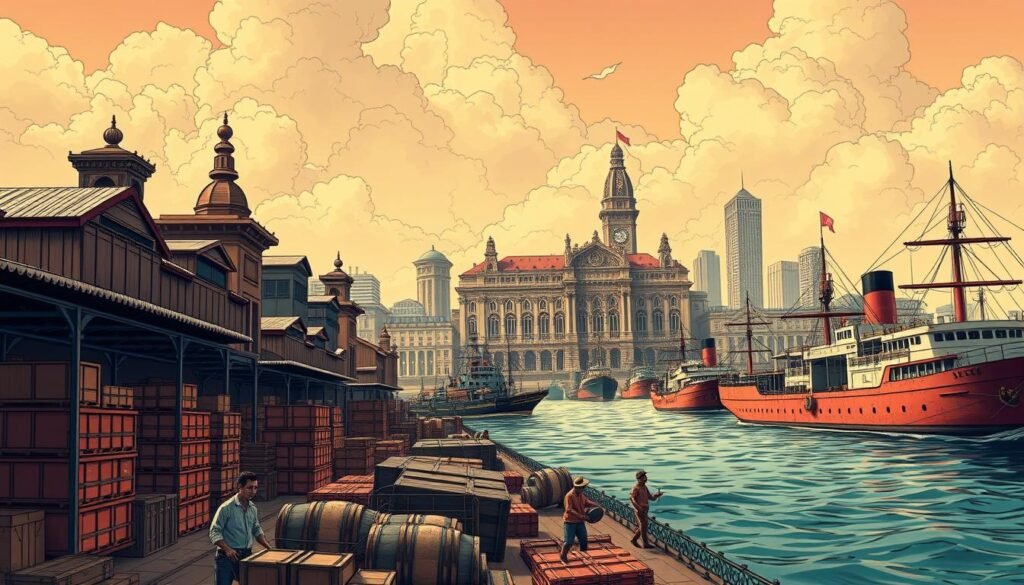
Shift from Isolation to International Commerce
Before 1834, Manila operated under mercantilist policies, limiting trade to Spanish-controlled routes. The arrival of foreign merchants brought new opportunities and challenges. British, American, and European traders introduced modern business practices and diversified the local economy.
This shift also led to the gradual dismissal of outdated mercantilist practices. The government began to adopt more open trade policies, fostering economic growth. Manila’s ports became a gateway for goods like sugar, abaca, and coffee, connecting the archipelago to global markets.
Economic Changes and Foreign Influence
The influx of foreign merchants spurred significant economic changes. Local industries adapted to meet international demand, creating new jobs and wealth. However, this also increased competition, forcing traditional businesses to innovate or risk decline.
Global trade policies further influenced local commerce. The completion of the Suez Canal in 1869 boosted trade efficiency, making Manila a vital link in global supply chains. These changes not only strengthened the economy but also fueled revolutionary ideas among the people.
In summary, the opening of Manila to world trade reshaped its economic landscape. It brought prosperity, innovation, and challenges, laying the groundwork for future struggles and triumphs.
The Rise of Nationalism and Call for Reform
The late 19th century saw a surge in nationalist sentiment across the archipelago. Exposure to liberal ideas abroad ignited a wave of reformist movements at home. Intellectuals like José Rizal became the voice of a growing call for change.
Rizal’s writings, such as Noli Me Tangere, challenged the oppressive policies of colonial rule. His works inspired many to question the state of society under Spain. These ideas spread quickly, fueling demands for equal rights and representation.
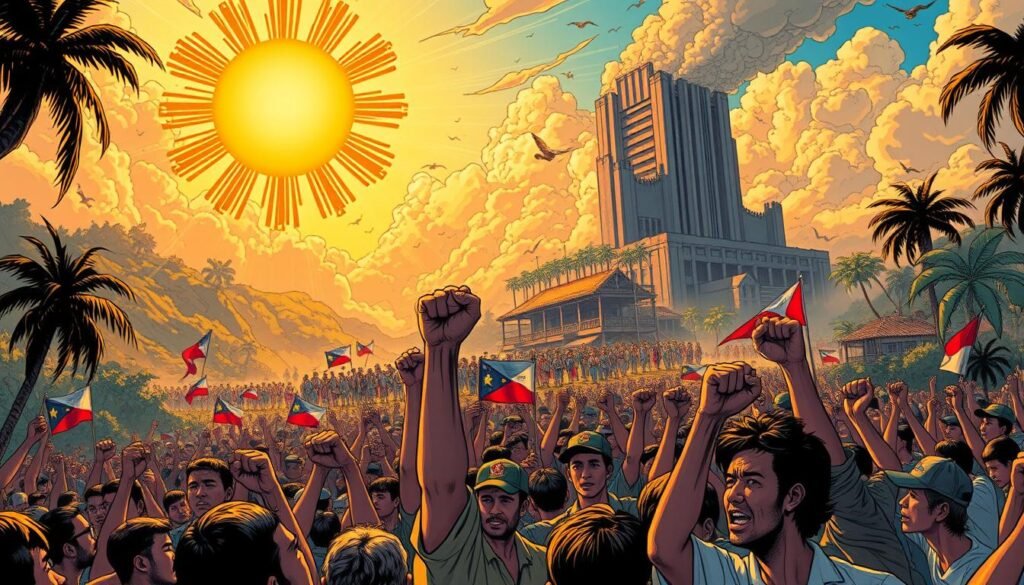
The Propaganda Movement played a crucial role in mobilizing the people. Leaders like Rizal and Marcelo del Pilar used publications like La Solidaridad to voice their demands. They called for reforms, including representation in the Spanish parliament and an end to forced labor.
These efforts were not isolated. They were part of broader international trends advocating for self-governance. The rise of nationalism in the archipelago mirrored similar movements across Asia and Europe.
Early reform movements laid the groundwork for future struggles. They united people across social classes, creating a shared vision of a free and just society. This period marked the beginning of a long journey toward independence.
The Spark: Cry of Pugad Lawin and Early Uprisings
In August 1896, a bold act of defiance ignited a movement that would reshape history. The Cry of Pugad Lawin marked the beginning of a fierce struggle against oppressive colonial rule. This event symbolized the people’s refusal to accept injustice any longer.
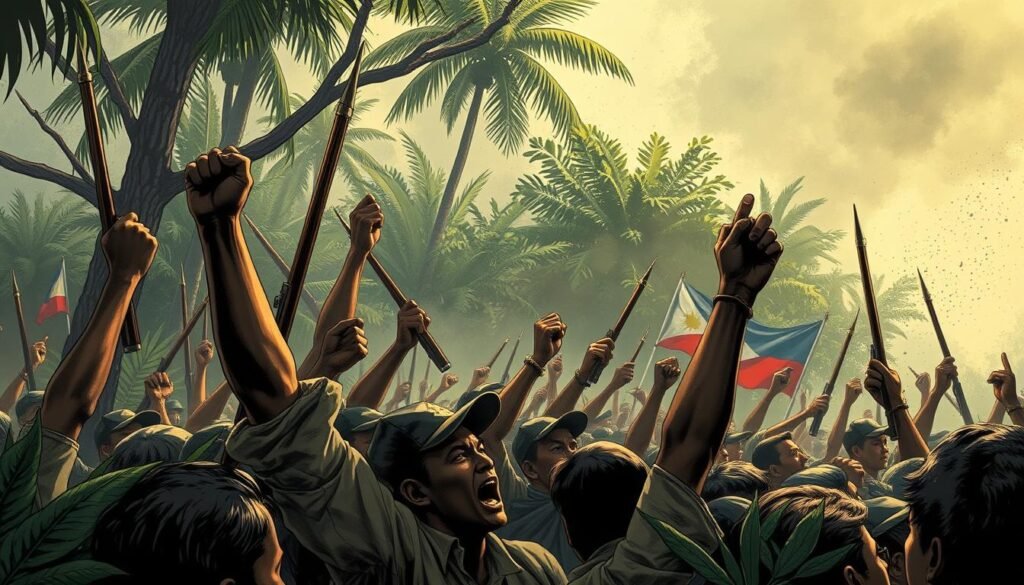
The Role of Taxation and Cedula Resistance
Taxation played a central role in fueling discontent. The cedula, a personal tax certificate, became a symbol of colonial oppression. Revolutionaries tore up their cedulas in a powerful act of defiance. This gesture signaled their rejection of unfair policies and their readiness to fight for freedom.
Tax policies were not the only issue. Forced labor and other oppressive measures added to the growing unrest. These actions pushed people across various provinces to join the uprising. The resistance spread quickly, uniting communities in a shared cause.
First Signs of Revolutionary Spirit
The early uprisings were marked by acts of courage and determination. In many provinces, small groups began organizing against colonial forces. These initial efforts laid the groundwork for a larger movement.
The rapid spread of revolutionary ideas showed the people’s readiness for change. Leaders emerged, inspiring others to take action. The time had come for a united stand against oppression.
| Key Aspect | Details |
|---|---|
| Event | Cry of Pugad Lawin (August 1896) |
| Symbolic Act | Tearing of cedulas |
| Impact | Spread of resistance across provinces |
| Outcome | Set the stage for armed struggle |
The events of August 1896 were a turning point. They showed the power of unity and the strength of the human spirit. This period marked the beginning of a long and challenging journey toward freedom.
Katipunan: The Revolutionary Movement
In 1892, a secret society emerged, destined to challenge colonial dominance. Known as the Katipunan, this organization aimed to unite Filipinos under a common cause. Founded by six visionaries, including Andrés Bonifacio, it became a beacon of hope for those seeking freedom.
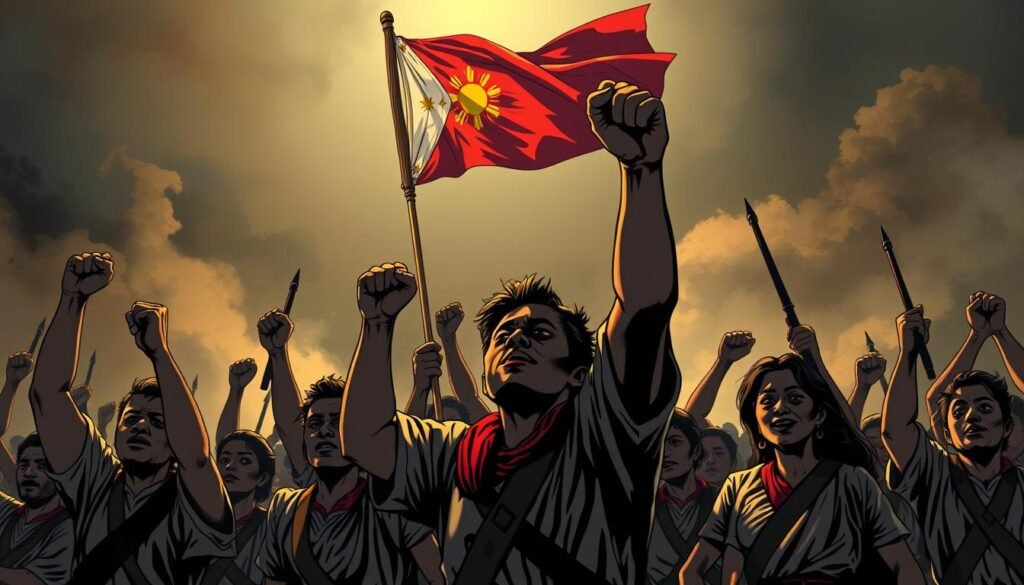
The Katipunan’s structure was designed for secrecy and efficiency. Members were divided into three ranks: Katipon, Kawal, and Bayani. Each rank had specific responsibilities, ensuring the organization’s smooth operation. This hierarchical system allowed the Katipunan to mobilize quickly and effectively.
Members came from diverse socio-economic backgrounds. Farmers, laborers, and intellectuals joined forces, united by their shared desire for change. This diversity strengthened the movement, bringing different perspectives and skills to the table.
Before the full-scale revolution, the Katipunan focused on recruitment and education. They published Kalayaan, a newspaper that spread revolutionary ideas. This publication played a crucial role in expanding their reach and inspiring new members.
“The Katipunan was not just an organization; it was a movement of the people, by the people, and for the people.”
The Katipunan’s activities laid the groundwork for the eventual uprising. They organized meetings, trained members, and prepared for the challenges ahead. Their efforts united different social classes, creating a powerful force against colonial rule.
| Aspect | Details |
|---|---|
| Formation | July 7, 1892 |
| Founding Members | 6 |
| Membership Ranks | Katipon, Kawal, Bayani |
| Key Publication | Kalayaan |
The Katipunan’s legacy is a testament to the power of unity and determination. It remains a cornerstone of Filipino history, inspiring future generations to fight for justice and freedom.
Key Figures: Bonifacio, Aguinaldo, and Rizal
Three remarkable individuals emerged as pillars of the fight for freedom. Their contributions shaped the course of history and inspired generations to come. Each leader brought unique strengths to the movement, leaving an indelible mark on the nation’s identity.
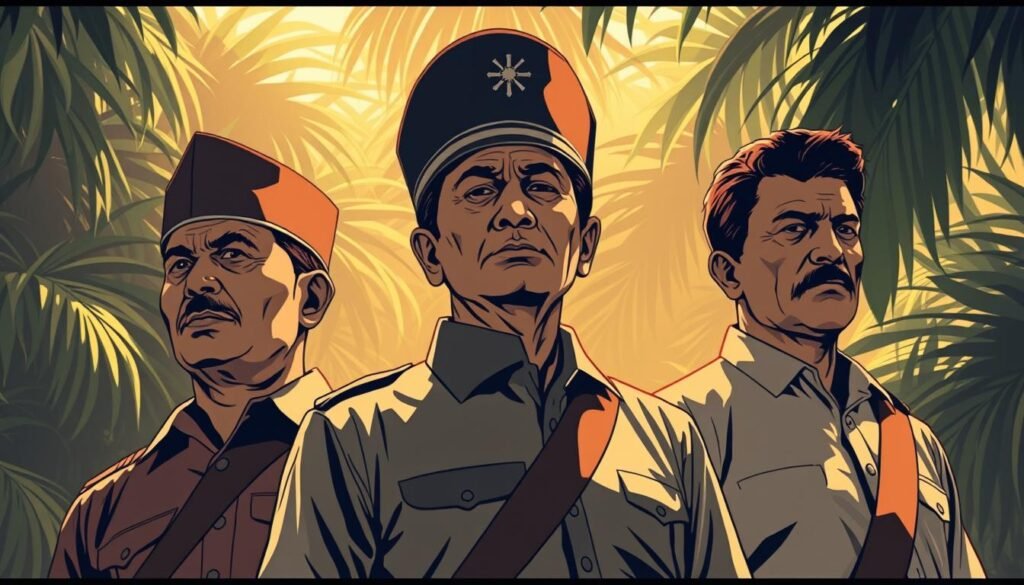
Andrés Bonifacio and the Formation of the Katipunan
Andrés Bonifacio, often called the “Father of the Revolution,” founded the Katipunan in 1892. This secret society aimed to unite people from all walks of life under a common cause. Bonifacio’s leadership was marked by his ability to inspire and mobilize the masses.
He believed in a consultative approach, valuing the input of every member. His vision and dedication laid the foundation for the eventual uprising. Bonifacio’s life was a testament to the power of unity and determination.
“The Katipunan was not just an organization; it was a movement of the people, by the people, and for the people.”
Emilio Aguinaldo’s Rise to Leadership
Emilio Aguinaldo emerged as a key figure after Bonifacio’s execution in 1897. Born into a relatively wealthy family, Aguinaldo’s education and strategic mindset set him apart. He quickly rose through the ranks, becoming a general by 1896.
Aguinaldo’s leadership style was more centralized, focusing on military efficiency. His return from exile in 1898 marked a turning point, as he declared the country’s independence. Aguinaldo’s movement toward self-governance inspired many, though it also led to internal conflicts.
José Rizal, though not directly involved in armed struggle, played a crucial role through his writings. His works, such as Noli Me Tangere, exposed the injustices of colonial rule. Rizal’s ideas ignited a sense of nationalism, influencing both Bonifacio and Aguinaldo.
These leaders embodied the spirit of the movement, each contributing in their own way. Their sacrifices and vision continue to inspire the country today. For more insights into their legacies, explore the debate on Bonifacio vs Rizal.
Major Battles and Strategic Locations
The struggle for freedom reached its peak through decisive battles that shaped the course of history. These confrontations tested the resolve of revolutionary forces and their leadership, altering the colonial balance of power. From naval clashes to ground engagements, each battle played a crucial role in the fight for independence.
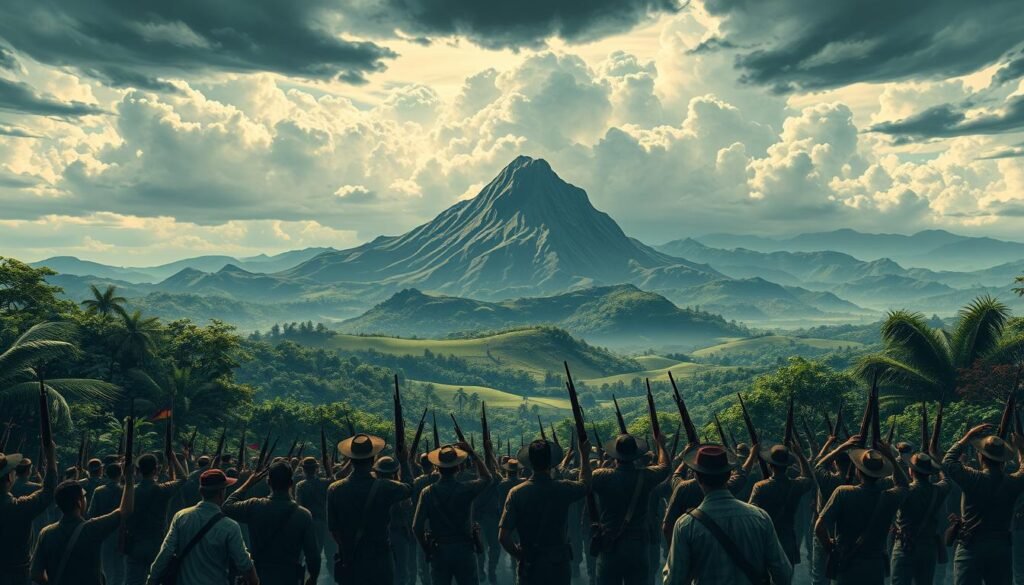
The Battle of Manila Bay
One of the most significant naval battles occurred on May 1, 1898, in Manila Bay. The U.S. Navy, under Commodore George Dewey, faced the Spanish fleet. Despite being outgunned, Dewey’s strategic leadership led to a decisive victory. This battle marked the end of Spanish naval dominance in the region.
The victory at Manila Bay had far-reaching consequences. It not only weakened Spanish control but also paved the way for future alliances. The battle demonstrated the importance of naval power in colonial conflicts.
Significant Engagements in Cavite and Beyond
On the ground, the Battle of Binakayan-Dalahican in November 1896 was a turning point. Revolutionary forces, led by Emilio Aguinaldo, achieved their first major victory. This success boosted morale and proved that colonial forces could be challenged.
Another key engagement was the Battle of Zapote Bridge in February 1897. General Emilio Aguinaldo’s forces clashed with Spanish troops under Governor-General Camilo de Polavieja. Despite heavy losses, the battle showcased the resilience and determination of the revolutionary leader and his troops.
- The Battle of Manila Bay weakened Spanish naval power.
- The Battle of Binakayan-Dalahican marked the first major victory for revolutionary forces.
- The Battle of Zapote Bridge demonstrated the resilience of revolutionary troops.
These battles were not just military confrontations; they were symbols of hope and determination. They inspired others to join the cause and strengthened the movement’s momentum. The legacy of these engagements continues to influence modern military strategies and national pride.
Internal Conflicts and Power Struggles within the Revolution
Internal rivalries often emerge in movements striving for change. The fight for independence was no exception, as differences in vision and leadership led to significant power struggles. These conflicts tested the unity of the movement and shaped its future.
One notable example was the division between the Magdiwang and Magdalo groups. These factions, both part of the broader movement, had differing approaches to achieving their goals. The Magdiwang favored a more inclusive strategy, while the Magdalo leaned toward centralized leadership. This tension often led to disagreements and weakened their collective efforts.
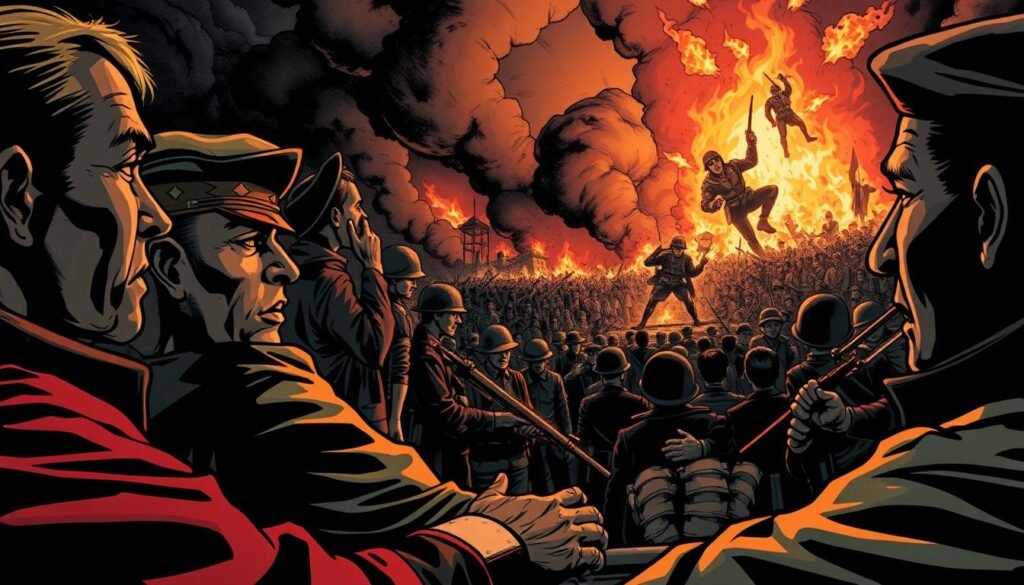
The impact of these conflicts was profound. They not only slowed progress but also created mistrust among members. For instance, the rivalry between Andrés Bonifacio and Emilio Aguinaldo escalated into a leadership crisis. This internal dissent ultimately led to Bonifacio’s execution, a turning point that further divided the movement.
Long-term consequences of these struggles were felt across the region. The lack of unity made it harder to resist external pressures, delaying the achievement of independence. Similar patterns of internal conflict were observed in other movements across Asia, highlighting the challenges of maintaining cohesion in revolutionary efforts.
| Faction | Leadership Style | Impact |
|---|---|---|
| Magdiwang | Inclusive | Advocated broader participation |
| Magdalo | Centralized | Focused on strategic efficiency |
These internal struggles serve as a reminder of the complexities of revolutionary movements. They underscore the importance of unity and shared vision in achieving lasting change. For more insights into how such conflicts shaped history, explore the impact of internal divisions in other regions.
Timeline of Significant Events
From 1896 to 1902, a series of pivotal events reshaped the archipelago’s future. These milestones marked the struggle for freedom and the eventual shift in power. Below is a detailed timeline of the major events that defined this period.
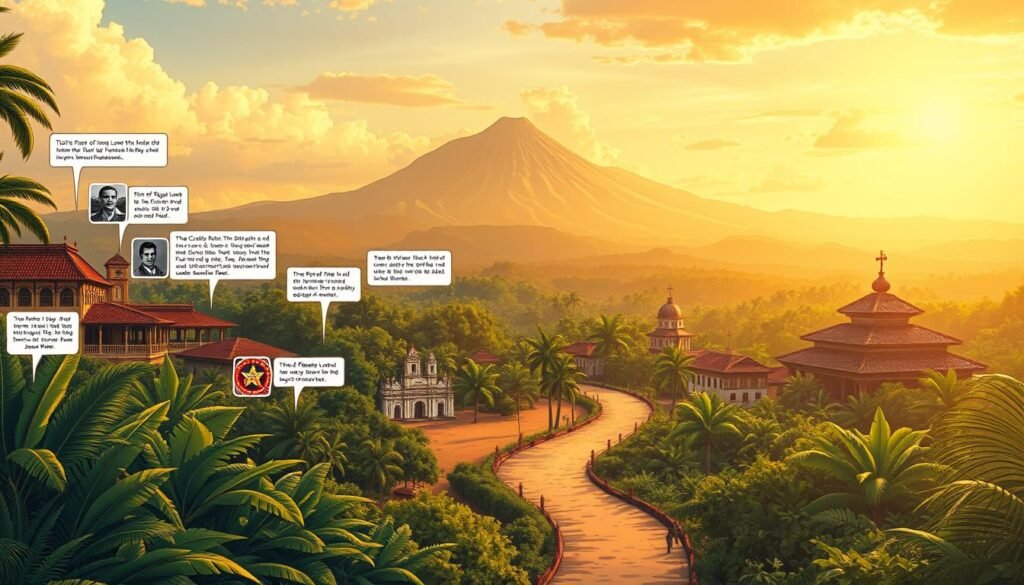
The late 19th century was a time of intense transformation. The society witnessed both triumphs and setbacks as the movement progressed. Each event played a crucial role in shaping the nation’s path to independence.
| Date | Event | Significance |
|---|---|---|
| August 1896 | Cry of Pugad Lawin | Marked the start of the uprising against colonial rule. |
| December 1896 | Execution of José Rizal | Fueled revolutionary sentiments across the society. |
| March 1897 | Tejeros Convention | Led to the election of Emilio Aguinaldo as President. |
| November 1897 | Biak-na-Bato Pact | Temporary ceasefire between revolutionary forces and Spain. |
| June 1898 | Declaration of Independence | Proclaimed the archipelago’s freedom from colonial power. |
| February 1899 | Philippine-American War Begins | Marked a new phase of conflict against foreign forces. |
| March 1901 | Capture of Emilio Aguinaldo | Signaled the decline of the revolutionary movement. |
These events highlight the resilience and determination of the people. The timeline provides a clear understanding of how each moment contributed to the broader struggle. For a deeper dive into this period, explore the detailed timeline of the revolution.
The years between 1896 and 1902 were filled with decisive actions and turning points. This article aims to contextualize these events and their lasting impact on the nation’s identity.
Exploring the Philippine Revolution: Key Milestones
The journey toward self-determination was marked by pivotal moments that reshaped the nation’s destiny. From declarations of independence to decisive battles, these milestones defined the struggle for freedom and unity.
One of the earliest turning points was the Cry of Pugad Lawin in August 1896. This act of defiance symbolized the people’s readiness to challenge colonial oppression. It ignited a wave of resistance that spread across provinces, uniting communities in a shared cause.
Leadership played a crucial role in guiding the movement. Emilio Aguinaldo emerged as a key figure, leading revolutionary forces to significant victories. His declaration of independence on June 12, 1898, marked a historic moment, proclaiming the nation’s freedom from colonial rule.
Foreign intervention also shaped the revolution’s trajectory. The United States entered the conflict during the Spanish-American War, altering the balance of power. The Treaty of Paris in December 1898 transferred control of the archipelago to the U.S., marking a new chapter in the struggle.
Despite setbacks, the movement achieved remarkable progress. The adoption of the Malolos Constitution in 1899 established the First Philippine Republic, showcasing the people’s commitment to self-governance. These milestones not only advanced the revolution but also laid the foundation for a distinct national identity.
| Milestone | Significance |
|---|---|
| Cry of Pugad Lawin (1896) | Marked the start of armed resistance against colonial rule. |
| Declaration of Independence (1898) | Proclaimed the nation’s freedom, led by Emilio Aguinaldo. |
| Treaty of Paris (1898) | Transferred control to the United States, ending Spanish rule. |
| Malolos Constitution (1899) | Established the First Philippine Republic, showcasing self-governance. |
These events highlight the resilience and determination of the people. They serve as a testament to the power of unity and the enduring spirit of the nation. For more insights into this transformative period, explore the detailed timeline of the revolution.
The Role of Foreign Powers: Spain and the United States
The influence of foreign powers played a decisive role in shaping the course of the uprising. Spain’s declining empire struggled to maintain control, while the United States emerged as a new force in the region. These external factors created both opportunities and challenges for the revolutionaries.
Spain’s waning imperial power weakened its hold on the archipelago. The Katipunan capitalized on this, organizing resistance across provinces like Cavite. However, internal divisions and limited resources hindered their progress. Spain’s inability to quell the uprising signaled the beginning of the end for its colonial rule.
The United States entered the conflict during the Spanish-American War in 1898. The Battle of Manila Bay marked a turning point, as U.S. forces defeated the Spanish fleet. This intervention shifted the balance of power, but it also complicated the revolutionaries’ goals. The Treaty of Paris, signed in December 1898, transferred control of the archipelago to the U.S., ending Spanish rule.
Foreign policies had mixed effects on the movement. While U.S. intervention weakened Spain, it also introduced new challenges. The revolutionaries faced a stronger adversary, leading to prolonged conflict. International politics further complicated matters, as the United States sought to establish its own influence in the region.
Key diplomatic and military episodes highlight this interplay. The capture of Emilio Aguinaldo in 1901 marked a significant setback for the revolutionaries. Despite these challenges, the movement demonstrated resilience and adaptability. The legacy of foreign involvement remains a critical aspect of the nation’s history.
| Event | Impact |
|---|---|
| Battle of Manila Bay (1898) | Ended Spanish naval dominance |
| Treaty of Paris (1898) | Transferred control to the U.S. |
| Capture of Aguinaldo (1901) | Weakened revolutionary leadership |
These events underscore the complex role of foreign powers in the uprising. They shaped the movement’s trajectory, leaving a lasting impact on the nation’s path to independence.
Political and Social Reforms During and After the Uprising
Amid the chaos of conflict, efforts to reshape governance and society took center stage. The movement for independence was not just about battles but also about addressing deep-rooted inequalities and colonial legacies. Political experiments and reform agendas emerged as critical components of this transformative period.
One of the earliest reform efforts was the Pact of Biak-na-Bato in December 1897. This agreement between revolutionary leaders and Spanish authorities aimed to establish a temporary ceasefire. It also included provisions for political reforms, such as representation in the Spanish government. While the pact ultimately failed, it highlighted the revolutionaries’ commitment to systemic change.
Key events and locations played a significant role in shaping reform policies. For instance, the exile of Emilio Aguinaldo to Hong Kong in December 1897 allowed him to strategize and garner international support. This period of exile also influenced his vision for governance, which later materialized in the Malolos Constitution.
Reforms extended to education, governance, and land tenure. The revolutionary government established schools to promote literacy and civic awareness. Land reforms aimed to redistribute resources more equitably, addressing the inequalities perpetuated by colonial policies. These efforts sought to create a more just and inclusive society.
However, the success of these reforms was mixed. While they laid the foundation for future progress, internal conflicts and external pressures limited their impact. The movement’s leaders faced challenges in implementing changes amidst ongoing battles and shifting alliances.
| Reform Area | Key Initiative | Outcome |
|---|---|---|
| Governance | Malolos Constitution | Established the First Philippine Republic |
| Education | Establishment of schools | Promoted literacy and civic awareness |
| Land Tenure | Redistribution of resources | Addressed colonial-era inequalities |
The legacy of these reforms is a testament to the movement’s broader goals. They aimed not only to achieve independence but also to create a society rooted in justice and equality. For more insights into the Propaganda Movement that inspired these efforts, explore this detailed resource.
Legacy and Impact on Filipino National Identity
Filipino identity today is deeply rooted in the struggles and triumphs of its ancestors. The events of the late 19th century not only shaped the nation’s history but also left a lasting imprint on its cultural and political landscape. The legacy of figures like Emilio Aguinaldo and José Rizal continues to inspire and influence national discourse.
Collective memory plays a vital role in shaping modern Filipino identity. Historical narratives, passed down through generations, highlight the resilience and unity of the people. These stories serve as a reminder of the sacrifices made for freedom and the enduring spirit of the nation.
Ongoing debates about the revolution’s impact on modern government and society reflect its complexity. Some argue that the movement laid the foundation for democratic ideals, while others point to unresolved issues like inequality and governance. These discussions underscore the relevance of history in addressing contemporary challenges.
Colonial legacies have been transformed into symbols of national unity. Monuments, museums, and educational programs celebrate the heroes of the past, ensuring their contributions are never forgotten. This integration of history into daily life strengthens the connection between past and present.
| Aspect | Impact |
|---|---|
| Cultural Legacy | Inspired art, literature, and national pride |
| Political Influence | Shaped democratic ideals and governance |
| Historical Narratives | Strengthened collective memory and identity |
| Modern Debates | Highlight ongoing relevance of historical events |
The journey toward independence was not just a fight for freedom but also a transformation of national identity. The lessons of the past continue to guide the nation, fostering a sense of unity and purpose. For a deeper understanding of how these events shaped Filipino nationalism, explore this detailed resource.
Comparative Insights: Other Decolonization Movements in Asia
Across Asia, the 19th and 20th centuries witnessed a wave of decolonization movements. These struggles shared common themes of resistance against colonial powers and the pursuit of self-governance. The Philippines United States relationship, for instance, mirrors the complex dynamics seen in other regions.
In the late 19th century, anti-colonial movements gained momentum across Asia. The Manila Bay conflict in 1898 marked a turning point, similar to pivotal battles in India and Vietnam. These events highlight how global power shifts influenced local struggles.
Leadership styles varied significantly across these movements. While figures like Emilio Aguinaldo in the Philippines focused on military strategy, leaders like Mahatma Gandhi in India emphasized non-violent resistance. These differences shaped the outcomes of their respective struggles.
International events also played a crucial role. The Treaty of Paris in 1898, which ended Spanish rule in the Philippines, was part of broader global changes. Similarly, the League of Nations provided a platform for anti-colonial voices from Asia and Africa.
Comparing these movements enriches our understanding of decolonization. It reveals how shared historical forces, like colonialism and nationalism, shaped diverse paths to independence. These insights remain relevant as nations continue to navigate their post-colonial identities.
| Movement | Key Event | Outcome |
|---|---|---|
| Philippines | Battle of Manila Bay (1898) | End of Spanish rule |
| India | Non-Cooperation Movement (1920) | Path to independence |
| Vietnam | Dien Bien Phu (1954) | End of French colonial rule |
These comparisons highlight the interconnectedness of anti-colonial struggles. They remind us that the fight for freedom was not isolated but part of a global movement. For more insights, explore the history of decolonization.
Conclusion: Economic and Cultural Transformations Post-Revolution
The transformation of the archipelago after the uprising reshaped its economic and cultural landscape. Key events, from the Cry of Pugad Lawin to the declaration of independence, marked a turning point in its history. These moments not only ended colonial rule but also laid the foundation for a new era of self-governance.
Economically, the city of Manila became a hub for trade and innovation, driving growth across the island. Cultural shifts followed, as traditional practices blended with modern influences, creating a unique national identity. These changes set the stage for the vibrant society seen today.
The legacy of leaders like Emilio Aguinaldo and José Rizal continues to inspire. Their vision for freedom and equality remains a cornerstone of national pride. As the nation moves forward, its resilience and unity serve as a testament to the enduring impact of its past struggles.
Looking ahead, the archipelago’s journey highlights the importance of adaptability and innovation. With initiatives like economic growth strategies, the future promises continued progress. Each day brings new opportunities to honor the past while building a brighter tomorrow.
FAQ
What was the significance of the Cry of Pugad Lawin?
The Cry of Pugad Lawin marked the start of the uprising against Spanish colonial rule. It symbolized the Filipinos’ determination to fight for independence and inspired widespread resistance.
How did colonial rule shape the Philippines before the uprising?
Spanish colonial rule imposed heavy taxes, limited political rights, and exploited resources. These conditions fueled discontent and laid the groundwork for the push for reform and independence.
What role did Manila play in the economic changes during that period?
Manila’s opening to world trade transformed its economy. It introduced foreign influence, modernized commerce, and created a wealthy class that later supported reform movements.
Who were the key leaders of the revolutionary movement?
Andrés Bonifacio founded the Katipunan, while Emilio Aguinaldo emerged as a military leader. José Rizal’s writings also inspired nationalist sentiments and calls for reform.
What were the major battles during the conflict?
The Battle of Manila Bay and engagements in Cavite were pivotal. These clashes demonstrated the Filipinos’ resolve and strategic capabilities against colonial forces.
How did foreign powers influence the uprising?
Spain sought to maintain control, while the United States intervened later, leading to a shift in colonial power. Both nations significantly impacted the outcome of the struggle.
What reforms emerged during and after the uprising?
The movement led to political and social changes, including demands for representation, land reform, and greater rights for Filipinos. These reforms shaped the nation’s post-colonial identity.
How did the uprising impact Filipino national identity?
The conflict fostered a sense of unity and pride among Filipinos. It became a cornerstone of their history, inspiring future generations to value independence and self-determination.
How does this movement compare to other decolonization efforts in Asia?
Similar to movements in India and Indonesia, the Filipino struggle highlighted resistance to colonial rule. It emphasized the shared experiences of Asian nations in their fight for sovereignty.
Source Links
- Cry of Pugad Lawin
- Debate on the date and place of 1896 ‘Cry’ for PH freedom
- History of the Philippine Revolution – National Commission for Culture and the Arts
- Philippine Revolution
- Philippines – Colonialism, Revolution, Independence | Britannica
- Colonial Contractions: The Making of the Modern Philippines, 1565–1946 – Oxford Research Encyclopedia of Asian History
- History of the Philippines | People, Spain, United States, Revolution, Map, & Facts | Britannica
- Philippine-American War, U.S. imperialism, Emilio Aguinaldo, Philippines, Spanish-American War, colonialism, American expansion, 1899-1902
- Remembering José Rizal, Filipino Revolutionary | In Custodia Legis
- Vicente L. Rafael – Center for Cultural Studies
- The Cry of Pugadlawin
- The Philippine Left Milieu
- National Historical Commission of the Phillippines
- Katipunan
- The Katipunan – History, Significance, and People Leading to Philippine Independence | Kapampangan Media
- In Focus: Andres Bonifacio and the 1896 Revolution – National Commission for Culture and the Arts
- 3 Revolutionary Heroes of the Philippines
- Rizal planted seed of revolution; Bonifacio watered it
- List Of Philippine Revolution Battles
- Philippine Insurrection, 1899-1902
- The Philippine Revolution: A Fight for Freedom
- Communist armed conflicts in the Philippines
- Timeline of the Philippine Revolution
- July 4, 1946: The Philippines Gained Independence from the United States | The National WWII Museum | New Orleans
- The History Of The Philippine Revolution
- Philippine Revolution
- Philippine Revolution | Facts, Leaders, & Significance | Britannica
- Spanish-American War and the Philippine-American War, 1898-1902 – Golden Gate National Recreation Area (U.S. National Park Service)
- Milestones in the History of U.S. Foreign Relations
- The People Power Revolution, Philippines 1986
- People Power at 25: Long road to Philippine democracy
- From “Isang Bagsak” to #FilipinxForBlackLives, the Filipino Identity Has Always Been Political
- The legacy of American imperialism in the Philippines: From colonisation to modern-day neocolonialism – Honi Soit
- A history of Philippine Independence Day
- S0080440123000233jra 345..369
- Decolonization and Revolution — EGO
- The Constitution of the Philippines and transformative constitutionalism | Global Constitutionalism | Cambridge Core

